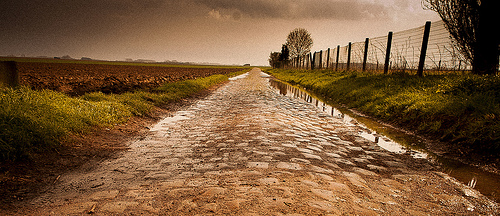
“Sometimes you don’t need a plan, you just need big balls,” said Tom Boonen ahead of this weekend’s racing. I’d have thought that larger balls would be more susceptible to damage on Paris-Roubaix’s famously irregular road surfaces – but then I haven’t won the race four times and Tom has. Boonen came second this year. After testing, Mat Hayman’s balls proved fractionally larger.
Paris-Roubaix is an absorbing race to watch. You watch it unfold, never really knowing what’s significant and what’s not. For example, Etixx-Quick Step put Tony Martin to work on the front with 120km to go. It seemed a waste of his energy and futile when the group behind started to near a couple of dozen kilometres later. However, that group never actually caught up and Fabian Cancellara and Peter Sagan – the two biggest favourites – never actually saw Tom Boonen and company again.
Hayman, meanwhile, had got into the day’s break even earlier on. It’s the kind of thing you don’t even pay much attention to because the break hardly ever stays away to the finish. What it bought him was a good headstart and perhaps a less-frenzied approach to each of the cobbled sectors, so when the other riders who would eventually contest the sprint caught him, he was fresh enough that he could hang on. If he’d ridden in the peloton, he’d never even have found himself in that position.
The sprint itself was from being a likely outcome. We were left with a five-man leading group (that also contained Ian Stannard) in the closing kilometres, but either none of these five wanted to sprint or all of them thought they could escape the other four. Operating to some unseen rota of ineffective attacks, the five riders took it in turn to try and get away until the road ran out and they were committed to velodrome shenanigans.
Of the five, Hayman would have been most people’s fifth choice to win a sprint. When he led out the group, this would view would have been cemented. But Paris-Roubaix is a long and tiring race and no-one really has much left at the end. Everyone sprinted at much the same speed, which meant no-one could get past the Australian.